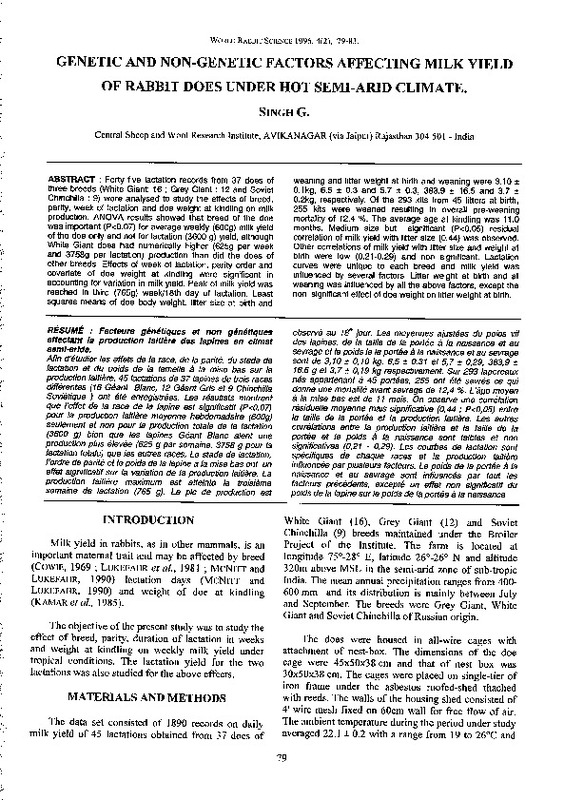JavaScript is disabled for your browser. Some features of this site may not work without it.
Buscar en RiuNet
Listar
Mi cuenta
Estadísticas
Ayuda RiuNet
Admin. UPV
GENETIC AND NON-GENETIC FACTORS AFFECTING MILK YIELD OF RABBIT DOES UNDER HOT SEMI-ARID CLIMATE
Mostrar el registro sencillo del ítem
Ficheros en el ítem
| dc.contributor.author | Singh, G.
|
|
| dc.date.accessioned | 2011-03-21T11:19:42Z | |
| dc.date.available | 2011-03-21T11:19:42Z | |
| dc.date.issued | 1996 | |
| dc.identifier.issn | 1257-5011 | |
| dc.identifier.uri | http://hdl.handle.net/10251/10466 | |
| dc.description.abstract | [EN] Forty five lactation records from 37 does of three breeds (White Giant: 16; Grey Giant: 12 and Soviet Chinchilla : 9) were analysed to study the effects of breed, parity, week of lactation and doe weight at kindling on milk production. ANOVA results showed that breed of the doe was important (P<0.07) for average weekly (600g) milk yield of the doe only and not for lactation (3600 g) yield, although White Giant does had numerically higher (625g per week and 3758g per lactation) production than did the does of other breeds. Effects of week of lactation, parity order and covariate of doe weight at kindling were significant in accounting for variation in milk yield. Peak of milk yield was reached in third (765g) week/18th day of lactation. Least squares means of doe body weight, litter size at birth and weaning and litter weight at birth and weaning were 3.1 O ± 0.1 kg, 6.5 ± 0.3 and 5. 7 ± 0.3, 383.9 ± 16.5 and 3. 7 ± 0.2kg, respectively. Of the 293 kits from 45 litters at birth, 255 kits were weaned resulting in overall pre-weaning mortality of 12.4 %. The average age at kindling was 11.0 months. Medium size but significant (P<0.05) residual correlation of milk yield with litter size (0.44) was observed. Other correlations of milk yield with litter size and weight at birth were low (0.21-0.29) and non significant. Lactation curves were unique to each breed and milk yield was influenced by several factors. Litter weight at birth and at weaning was influenced by all the above factors, except the non significant effect of doe weight on litter weight at birth. | es_ES |
| dc.description.abstract | [FR] Afín d'étudier les effets de la race, de la parité, du stade de lactation et du poids de la feme/le a la mise bas sur la production laitiere, 45 lactations de 37 tapines de trois races différentes (16 Géant B/anc, 12 Géant Gris et 9 Chinchilla Soviétique ) ont été enregistrées. Les résultats montrent que l'effet de la race de la lapine est significatif (P<0.07) pour la production laitiere moyenne hebdomadaire (600g) seulement et non pour la production totale de la lactation (3600 g) bien que les tapines Géant Blanc aient une production plus élevée (625 g par semaine, 3758 g pour la lactation totale) que les autres races. Le stade de lactation, /'ordre de parité et le poids de la /apine a la mise bas ont un effet significatif sur la variation de la production laitiere. La production laitiere maximum est atteinte la troisieme semaine de lactation (765 g). Le pie de production est observé au 18ª jour. Les moyennes ajustées du poids vif des tapines, de la tai/le de la portée a la naissance et au sevrage et le poids le la portée a la naissance et au sevrage sont de 3, 10±O,10 kg, 6,5 ± 0,31 et 5,7 ± 0,29, 383,9 ± 16,5 g et 3,7±O,19 kg respectivement. Sur 293 lapereaux nés appartenant a 45 portées, 255 ont été sevrés ce qui donne une mortalité avant sevrage de 12,4 %. L'age moyen a la mise bas est de 11 mois. On observe une corrélation résiduelle moyenne mais significative (0,44 ; P<0,05) entre la taille de la portée et la production laitiere. Les autres corrélations entre la production laitiere et la taille de la portée et le poids a la naissance sont faibles et non significatives (0,21 - 0,29). Les courbes de /actation sont spécifiques de chaque races et la production laitiere influencée par plusieurs facteurs. Le poids de la portée a la naissance et au sevrage sont influencés par tout les facteurs précédents, excepté un effet non significatif du poids de la lapine sur le poids de la portée a la naissance | |
| dc.language | Inglés | es_ES |
| dc.publisher | World Rabbit Science. ICTA. UPV | es_ES |
| dc.relation.ispartof | World Rabbit Science | |
| dc.rights | Reserva de todos los derechos | es_ES |
| dc.title | GENETIC AND NON-GENETIC FACTORS AFFECTING MILK YIELD OF RABBIT DOES UNDER HOT SEMI-ARID CLIMATE | es_ES |
| dc.type | Artículo | es_ES |
| dc.date.updated | 2011-03-21T11:13:17Z | |
| dc.identifier.doi | 10.4995/wrs.1996.275 | es_ES |
| dc.rights.accessRights | Abierto | es_ES |
| dc.description.bibliographicCitation | Singh, G. (1996). GENETIC AND NON-GENETIC FACTORS AFFECTING MILK YIELD OF RABBIT DOES UNDER HOT SEMI-ARID CLIMATE. World Rabbit Science. 04(2). https://doi.org/10.4995/wrs.1996.275 | es_ES |
| dc.description.accrualMethod | SWORD | es_ES |
| dc.relation.publisherversion | https://doi.org/10.4995/wrs.1996.275 | es_ES |
| dc.description.volume | 04 | |
| dc.description.issue | 2 | |
| dc.identifier.eissn | 1989-8886 | es_ES |








